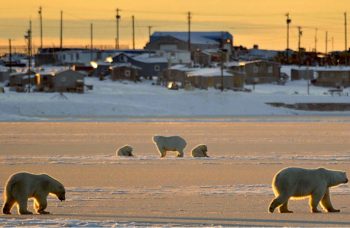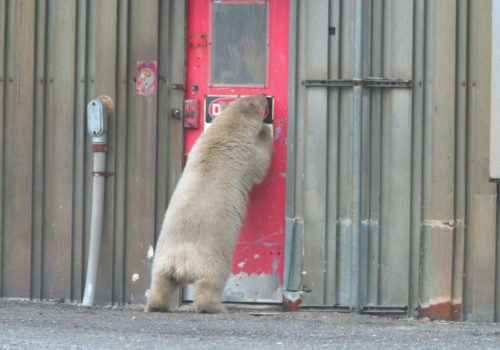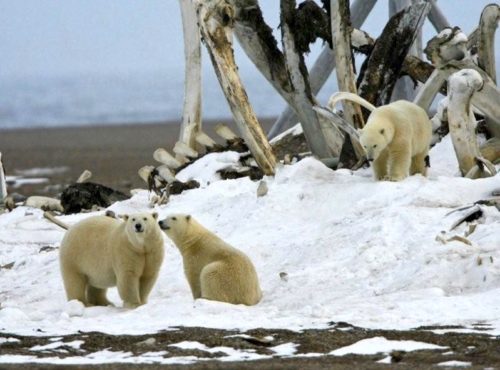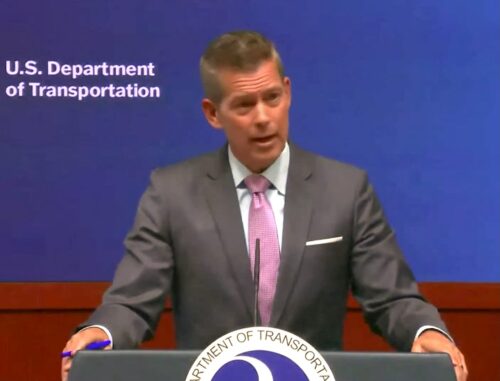
Nevertheless, it was reported just two weeks ago that Alaska has not had a polar bear attack since 1993.
This is a particularly blatant example of how the media skew polar bear ‘news’ for public consumption, aided by scientists with a particular message to sell.
Not surprisingly, a number of essential facts have been left out of this sensationalized account, in part because the polar bear specialist the media consulted left those facts out of his statement.
This is the sort of bias displayed by polar bear specialists that I discuss in my new book, The Polar Bear Catastrophe That Never Happened.
The impetus for the original ‘polar bears onshore’ story out of Anchorage (ADN, Saturday, 10 August 2019) was the report that a resident of Kaktovik had a close call with a bear on Monday 5 August:
“Polar bear encounters in Kaktovik aren’t new. But they’re happening a bit earlier than last year.”
“She [Annie Tikluk] was about 6 feet away from the bear, she said, and it had two paws on her deck. Then a neighbor ran across the street and chased the animal off.”
A USGS polar bear expert who lives in Anchorage was asked to weigh in (my bold):
“But this year, reports of polar bears in Kaktovik are starting “a little bit ahead of schedule,” said Todd Atwood, a research wildlife biologist who leads the U.S. Geological Survey’s polar bear research program.
“We tend to see aggregations starting around the middle or third week of August,” said Atwood, who is based in Anchorage.
The bears make their way to land from the Beaufort Sea around this time of year and await the return of sea ice. There’s a lot of variation from one year to the next in terms of when the bears come ashore, Atwood said. Compared to 2017, for instance, this year is only about a week ahead of schedule.”
The ADN story went on to explain (my bold, links in original):
“More significant is the change over a longer period of time. The length of the southern Beaufort Sea’s ice melt season — the time between sea ice breakup in summer and freeze-up in the fall — “has increased substantially since the late 1990s,” according to a 2016 research paper that Atwood co-authored and that the Anchorage Daily News reported about when it came out.
As the Arctic warms, changes in sea ice habitat have coincided with evidence that polar bears’ use of land habitat is increasing, the research found.”
So despite the original story clearly stating that Atwood’s work was three years old, the next day (11 August 2019) the Associated Press out of Anchorage re-jigged the story – “Alaska scientists say polar bear encounters to increase” – to make it sound like Atwood’s study had just come out and that these were new results that had just been made public.
Although there was a link in the AP story to the previous day’s story about the Kaktovik polar bear encounter, there was no link to the three-year-old study or to any of the three-year-old stories about it.
The sensationalized piece also added the ‘information’ that Kaktovik “residents have reported [polar bear] sightings as early as May“.
Atwood’s study from three years ago (more on that below) found that the few Southern Beaufort Sea polar bears that chose to come to land in summer between 2010 and 2013 had spent, on average, 36 days longer onshore than they had in the 1990s.
The authors reported no negative effects from this longer time ashore (in fact, Atwood admitted it may be advantageous) but you wouldn’t know that from yesterday’s AP story, which has been picked up by mainstream news outlets across North America and around the world.
FACTS LEFT OUT OF THESE STORIES
Here is what I wrote on the Atwood study back in 2016:
Two recent studies showed that while more polar bears came to land during the ice-free period in the Southern Beaufort between 2010 and 2013 (and stayed longer than they did in the late 1990s), there were no negative effects on polar bear health or survival from spending ~ 2.5 months onshore vs. 1.5 months even though the bears lost weight (Atwood et al. 2016; Whiteman et al. 2015).
A similar result came from work in the Chukchi Sea – less summer ice meant more time onshore for a larger number of bears but without negative effects on health or survival (Rode and Regehr 2010; Rode et al. 2013, 2014).
An earlier paper on polar bears attracted to whalebone piles in Barrow (Heereman and Peacock 2013) found that bears visited all through the fall (starting in November 2010) and continued into the dead of winter (February 2011).
Kaktovik, Alaska (on Barter Island) has been attracting significant numbers of polar bears ashore in summer since the early 2000s (Miller et al. 2006, 2015), as have a few other locations.
Most whaling at Kaktovik is now done in the late summer (September) rather than the spring or fall (October), in part due to sea ice changes but also because bowhead whale numbers are higher than they have been in a century.
Kaktovik residents are adapting to those changes by shifting the primary season of the hunt earlier in the summer – and unfortunately, that has had consequences for polar bears as well as the people.
Bears have learned by experience in recent years that it may be worth their while to stay ashore over the summer rather than stay on the ice as it retreats.
Here is what Miller and colleagues (2006: 1) had to say about those changes (my bold):
In 1999, the U.S. Fish and Wildlife Service (FWS) began flying aerial surveys along the Beaufort Sea coastline between Cape Halkett and Jago Spit near Barter Island (Figure 1) during the fall open-water period (September-October) to determine the distribution and abundance of polar bears in the central Beaufort Sea coastal area.
Results indicate that the majority (73%) of polar bears observed in 2000-2004 were located within 12 km of Barter Island, where unused portions of bowhead whales (Balaena mysticetus) were deposited by Kaktovik residents during fall whaling.
…
The population of Kaktovik was 293 residents in 2000, most of whom are Native (U.S. Census Bureau 2000). Bowhead whale hunting has been and continues to be an important part of the local culture and lifestyle (Jacobson and Wentworth 1982).
Recent fall bowhead whale harvests were first recorded at Kaktovik in 1964; since 1989, two to four whales have been harvested annually (Koski et al. 2005).
The majority (64%) of whales are taken between September 1 and 20 (Koski et al. 2005).
In recent years, a significant trend towards earlier harvest has occurred, probably because of improved hunting techniques and equipment, and perhaps also because the size of the bowhead population is increasing, and whales may be more numerous near Kaktovik early in the hunting season (Koski et al. 2005).“
More on Kaktovik bears here (and here), with quotes from past stories and links to more pictures, and on the status of SB bears here.
I’ll add that polar bears are known to visit Kaktovik and other small communities across the coast of Alaska at all times of the year, not just in summer, and virtually all of the bears photographed onshore in Alaska in recent years have been fat and healthy.
The photo below shows a fat adult female and her two fat cubs checking out the whalebone pile at Kaktovik in April 2016, a time of year when bears are usually on the sea ice hunting seals:
Dr. Susan Crockford is a University of Victoria (British Columbia, Canada) zoologist who specializes in Holocene mammals, including polar bears and walrus. Her new book is The Polar Bear Catastrophe That Never Happened (Amazon).
Read more and references at Polar Bear Science





















Yeah but the AP is faking its news just like CNN and the NYT’s fakes the news its no wonder the American Public don’t trust the M.S. Media anymore
I am getting encouraged a scientist that isn’t afraid to speak the truth .
Crying wolf for decades in order to fleece people is wearing out never the less
Susan Crockford is a breath of fresh air and appreciated .
Stop the trophy hunting and leave the bears alone .